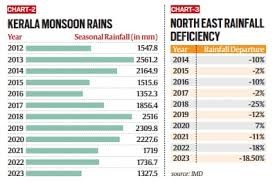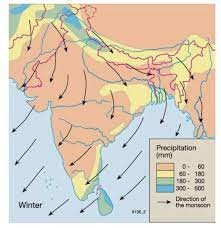Description

Disclaimer: Copyright infringement not intended.
Context
- This is the eighth year in a row that monsoon rainfall in India has been broadly in the normal range. But behind this figure lie sharp regional as well as daily variations.
- Climate change is one reason behind this.
Details

- The monsoon seasons this year ended with 94 percent overall rainfall, making it the eighth year in succession that the seasonal rainfall has been broadly in the normal range.
- This makes it seem as though monsoon rainfall in the country has been remarkably consistent in recent years.
- There have been large variations in the distribution of rainfall, in spatial as well as temporal terms.
- While some days produced very heavy rainfall, prolonged periods went extremely dry.
- Similarly, a majority of the districts received very little rainfall during most of the season.
- This rainfall variability only seems to be increasing, possibly because of climate change.
- At the district level, rainfall has been highly erratic.
- Northwest and central parts of the country received more than 100 percent rains during the season, while eastern and North-Eastern regions got barely 80 percent.
- The southern part of the country also had large deficits for most of the monsoon season.
- The region finally ended with 92 percent rains for the season.
- This year, the states of Bihar, Jharkhand, and West Bengal received particularly poor rainfall, each ending with a deficiency of more than 20 percent.
- Nagaland, Manipur, Mizoram, and Tripura also had more than 20 percent deficit.
- The increasingly erratic behavior of monsoon rainfall is usually blamed on climate change, but it is not that simple.
- There are many other factors at play.
- This year’s monsoon, for example, was expected to be hit by the prevailing El Nino in the eastern Pacific Ocean.
- In previous years, El Nino events have resulted in large rainfall deficits during monsoon.
- However, it did not have a similar impact on the rainfall this year, at least in overall quantitative terms.

Role of Climate Change:
- Climate change has increased the uncertainty of weather events.
- Even if extreme actions are made to instantly reduce greenhouse gas emissions, which are known to be the cause of global warming and climate change, the unpredictability of monsoon rainfall is likely to remain.
- Right now, it appears that the sole copying mechanism is better preparedness to deal with unpredictable circumstances.
- Increased emphasis on disaster preparedness, initiatives to reduce bottlenecks that increase the impacts of extreme weather events - such as urban flooding - and strengthening climate resilience in new and old infrastructure are all predicted to receive more attention.
Rainfall Distribution Categories in India:
- On an all-India basis, the Indian Meteorological Department maintains five rainfall distribution classifications.
They are as follows:
Normal or Near Normal: When the percentage deviation of actual rainfall is +/-10% of the LPA (Long Period Average), i.e., between 96-104% of the LPA.
- Below normal: When actual rainfall deviates from LPA by less than 10%, or 90-96% of LPA.
- Above normal: When real rainfall exceeds 104-110% of LPA.
- Deficient: When actual rainfall falls short of 90% of LPA.
- Excess: When actual rainfall differs from LPA by greater than 110%.
What is a 'Long Period Average'?
- The LPA is the country's average rainfall from 1961 to 2010, which is 87 centimetres.
IMD (Indian Meteorological Department):
- The India Meteorological Department was founded in 1875.
- It is the country's National Meteorological Service and the primary government agency for meteorology and related subjects.
- Ministry: Ministry of Earth Sciences
- Headquarters: New Delhi.
Functions of IMD:
- To collect meteorological data and give current and predicted meteorological information for weather-sensitive operations such as agriculture, irrigation, shipping, aviation, offshore oil drilling, and so on.
- To issue warnings of extreme weather events such as tropical cyclones, northwestern, dust storms, heavy rains and snow, cold and heat waves, and so on, which cause loss of life and property.
- To offer meteorological data for agricultural, water resource management, industry, oil exploration, and other nation-building activities.
Basic Knowledge about Monsoon
- Monsoons are most commonly experienced in the tropical region between 20° N and 20° S.
- India's climate is classified as ‘monsoon'. This type of climate is most common in Asia's south and southeast.
- The monsoon season occupies two of India's four seasonal divisions, namely.
- The southwest monsoon season - Rainfall received from the southwest monsoons is seasonal in character, which occurs between June and September.
- The retreating monsoon season - The months of October and November are known for retreating monsoons.
Factors Influencing the Formation of the South-West Monsoon
- The differential heating and cooling of land and water results in low pressure over India's landmass, while the waters around it experience relatively high pressure.
- The summer movement of the Inter Tropical Convergence Zone (ITCZ) over the Ganga plain (this is the equatorial trough that is ordinarily located around 5°N of the equator). During the monsoon season, it is also known as the monsoon trough.
|
Inter Tropical Convergence Zone
The Inter Tropical Convergence Zone (ITCZ,) is a broad trough of low pressure in equatorial latitudes. This is where the northeast and the southeast trade winds converge. This convergence zone lies more or less parallel to the equator but moves north or south with the apparent movement of the sun.
|
- The presence of a high-pressure area over the Indian Ocean east of Madagascar, about near 20°S. The strength and location of this high-pressure region have an impact on the Indian Monsoon.
- During the summer, the Tibetan plateau becomes extremely hot, resulting in strong vertical air currents and the creation of low pressure across the plateau at roughly 9 km above sea level.
- The existence of the tropical easterly jet stream across the Indian peninsula during summer and the movement of the westerly jet stream to the north of the Himalayas.
- Tropical Easterly Jet (also known as African Easterly Jet).
- Southern Oscillation (SO): When the tropical eastern south Pacific Ocean has high pressure, the tropical eastern Indian Ocean has low pressure. However, there occurs a pressure reversal in certain years, and the eastern Pacific has lower pressure than the eastern Indian Ocean. The SO refers to this periodic fluctuation in pressure circumstances.
Mechanism
Onset of the South-West Monsoon

- With the apparent movement of the Sun, the location of the ITCZ varies north and south of the equator.
- The sun shines vertically over the Tropic of Cancer in June, and the ITCZ shifts northward.
- Under the influence of the Coriolis force, the southern hemisphere's southeast trade winds cross the equator and begin blowing in a southwest-to-northeast direction.
- As they pass over the warm Indian Ocean, these winds pick up moisture.
- The ITCZ shifts to 20°-25° N latitude in July and is positioned in the Indo-Gangetic Plain, while the southwest monsoons blow from the Arabian Sea and the Bay of Bengal.
- The ITCZ in this position is known as the Monsoon Trough.
- The movement in ITCZ position is also related to the occurrence of the westerly jet stream withdrawing from its position over the north Indian plain, south of the Himalayas.
- Only after the western jet stream has left the region does the easterly jet stream (Somali Jet) arrive along 15°N latitude.
- This easterly jet stream is blamed for the monsoon's failure in India.
- The relief and thermal low pressure over northwest India change the direction of these winds as they reach the land.
- The monsoon approaches the Indian subcontinent in two ways:
- The Arabian Sea branch consists of monsoon winds that originate over the Arabian Sea.
- The Arakan Hills along Myanmar's coast deflect a large section of the Bay of Bengal branch towards the Indian subcontinent.
- As a result, the monsoon approaches West Bengal and Bangladesh from the south and southeast rather than the southwest.
Retreating of Monsoon

- The monsoon had left western Rajasthan by the first week of September.
- It will have left Rajasthan, Gujarat, the Western Ganga Plain, and the Central Highlands by the end of the month.
- By early October, the low-pressure system had covered the northern regions of the Bay of Bengal and has passed over Karnataka and Tamil Nadu.
- By the middle of December, the center of low pressure had completely departed the Peninsula.
- A clear sky and rising temperatures herald the end of the southwest monsoon season.
- The ground remains damp. The excessive temperature and humidity have made the weather miserable.
- This is referred to as the 'October heat.' The temperature begins to drop dramatically in the second half of October, especially in northern India.
- The weather in north India during the receding monsoon is dry, but rainy in the eastern section of the Peninsula.
- The rainiest months of the year are October and November in this area.
Monsoon Retreat - Temperature, Pressure, and Wind
- The clouds disperse as the monsoons pass, and the sky clears.
- During the day, the temperature begins to fall.
- The diurnal temperature range extends due to a lack of cloud cover.
- As the monsoons retreat, the monsoon trough weakens and shifts southward. As a result, the pressure gradient is quite low.
- Unlike the south-west monsoon, the start of the north monsoon is not precisely defined.
- Local pressure conditions influence wind direction across large parts of the country.
Season of Retreating Monsoon – Cyclone
- The most severe and catastrophic tropical cyclones form in the Indian Ocean, notably in the Bay of Bengal.
- The months of October and November have the highest cyclone frequency.
- Cyclones form more frequently in October and November, with the Bay of Bengal producing more than the Arabian Sea.
- Coastal locations in Tamil Nadu, Andhra Pradesh, Odisha, and West Bengal are particularly prone to strong storms.
- Many cyclones that impact India's eastern coast south of 15 degrees north latitude make their way through the southern peninsula and into the Arabian Sea.
- During this time, they may weaken, but when they re-enter the atmosphere over the Arabian Sea, they intensify into cyclonic storms.
.jpg)
Season of Retreating Monsoon - Precipitation
- With the southwest monsoons fading, humidity and cloud cover have decreased dramatically, and most of the country remains dry.
- From October to November, the major rainy season in Tamil Nadu and neighbouring Andhra Pradesh to the south of the Krishna delta, as well as a secondary rainy season in Kerala, last.
- The receding monsoons accumulate moisture while travelling over the Bay of Bengal, culminating in this rainfall.
- Assam, Nagaland, Meghalaya, Mizoram, Arunachal Pradesh, Sikkim, Manipur, Tripura, and the north-eastern portion of West Bengal
- Rain fell heavily in the eastern slopes of the Western Ghats, as well as a wide area of the northern plain, Odisha, Madhya Pradesh, Andhra Pradesh, and Tamil Nadu.
|
PRACTICE QUESTION
Discuss the impact of climate change on monsoon patterns in India. How have abnormal monsoon events influenced various sectors of the economy, and what measures can be taken to mitigate their effects? (250 words)
|



















